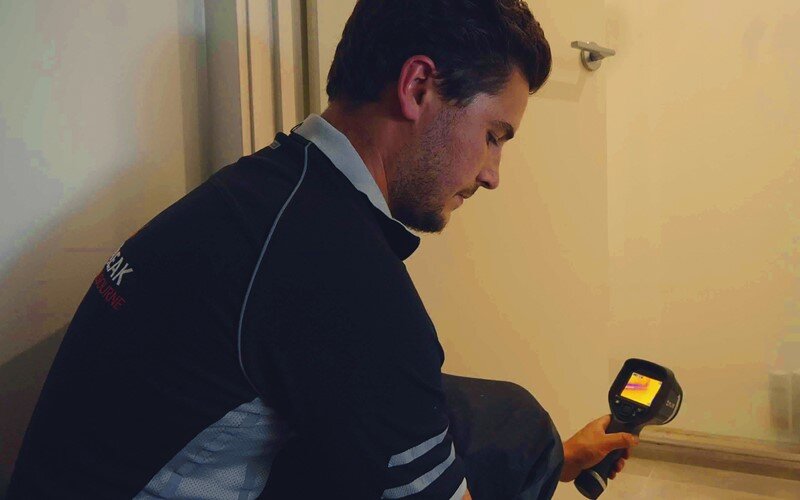Just how to Find as well as Repair Water Leaks-- A Comprehensive Guide
Just how to Find as well as Repair Water Leaks-- A Comprehensive Guide
Blog Article
We have discovered the article relating to Top leak detection hacks listed below on the web and thought it made perfect sense to relate it with you here.

Early detection of dripping water lines can mitigate a potential disaster. Some tiny water leakages may not be visible.
1. Examine the Water Meter
Every house has a water meter. Checking it is a guaranteed way that helps you find leakages. For beginners, shut off all the water sources. Ensure nobody will purge, make use of the faucet, shower, run the washing device or dish washer. From there, go to the meter and watch if it will change. Considering that no one is utilizing it, there ought to be no motions. If it moves, that indicates a fast-moving leakage. Also, if you find no changes, wait an hour or two and inspect back once again. This implies you may have a slow leakage that might even be below ground.
2. Inspect Water Consumption
If you identify unexpected modifications, regardless of your consumption being the same, it indicates that you have leaks in your plumbing system. An abrupt spike in your bill shows a fast-moving leak.
At the same time, a constant increase monthly, despite having the exact same routines, shows you have a sluggish leakage that's additionally gradually escalating. Call a plumber to thoroughly inspect your building, specifically if you feel a cozy area on your flooring with piping underneath.
3. Do a Food Coloring Test
When it comes to water usage, 30% originates from commodes. Test to see if they are running appropriately. Drop specks of food color in the tank and wait 10 mins. There's a leak between the container and also bowl if the color in some way infiltrates your dish throughout that time without flushing.
4. Asses Outside Lines
Don't neglect to inspect your outdoor water lines too. Ought to water seep out of the connection, you have a loosened rubber gasket. One small leak can throw away lots of water as well as increase your water expense.
5. Evaluate and Examine the Scenario
Homeowners must make it a habit to check under the sink counters and also inside closets for any kind of bad odor or mold growth. These two warnings show a leakage so timely attention is required. Doing regular examinations, even bi-annually, can save you from a significant trouble.
Check for discolorations and compromising as most devices as well as pipes have a life expectancy. If you suspect leaking water lines in your plumbing system, do not wait for it to intensify.
Early detection of dripping water lines can alleviate a potential calamity. Some little water leaks might not be noticeable. Inspecting it is a guaranteed method that assists you discover leaks. One tiny leakage can lose heaps of water and also surge your water expense.
If you think leaking water lines in your plumbing system, do not wait for it to intensify.
How to Know If Your Home Has a Hidden Leak
Water Meter Reveals Inexplicable Water Usage
If you’d like to test whether or not there’s a leak somewhere in your home, you can do this using your water meter. Here is how to conduct the test:
Don’t use any water in your home for at least 30 minutes; this also means not turning on faucets or water-using appliances.
Go outside, and check your water meter for activity.
If your water meter shows that there was activity, even though no one was using any water, this proves that there is a leak in your home.Visible Mold or Mildew Growth
Leaks behind walls create moist, dark environments that allow mold and mildew to grow and thrive. Eventually, you might see mold growth forming on the wall closest to a hidden leak.
If mold is growing in an area that receives a high amount of moisture, such as a bathroom, it may simply be an indication that better ventilation is needed. However, if you see mold growth on a wall or the ceiling in an area where you would not expect, you probably have a hidden leak.
Musty, Mildew Odor
Sometimes you might not be able to see the mold or mildew that is growing as a result of a leak. However, the smell can give the problem away just as easily. If you catch a whiff of something musty, there’s a good chance that old water is collecting somewhere in your home that you can’t see.
Stained/Warped Walls, Ceilings, or Floors
When your home soaks up water, a variety of red flags can become visible, including ceiling stains, bubbling drywall, warped walls, and sagging floors. While these issues can be caused by excess humidity, they can also be signs that a pipe or plumbing connection has started leaking behind your walls.
Inexplicably High Water Bill
After a while, you get a general sense for what your water bill should be. If you own a pool or sprinkler system, your bill will tend to be higher during summer. However, if you receive a water bill that seems especially high, and you can’t figure out what caused it, then you may have a hidden leak somewhere that’s increasing your bill.
https://www.plumbingjoint.com/blog/2019/july/how-to-know-if-your-home-has-a-hidden-leak/

We hope you enjoyed our section about Finding hidden leaks. Thanks so much for taking the time to read our content. Don't hesitate to take the time to promote this page if you appreciated it. I praise you for your time. Kindly stop by our website back soon.
Report this page